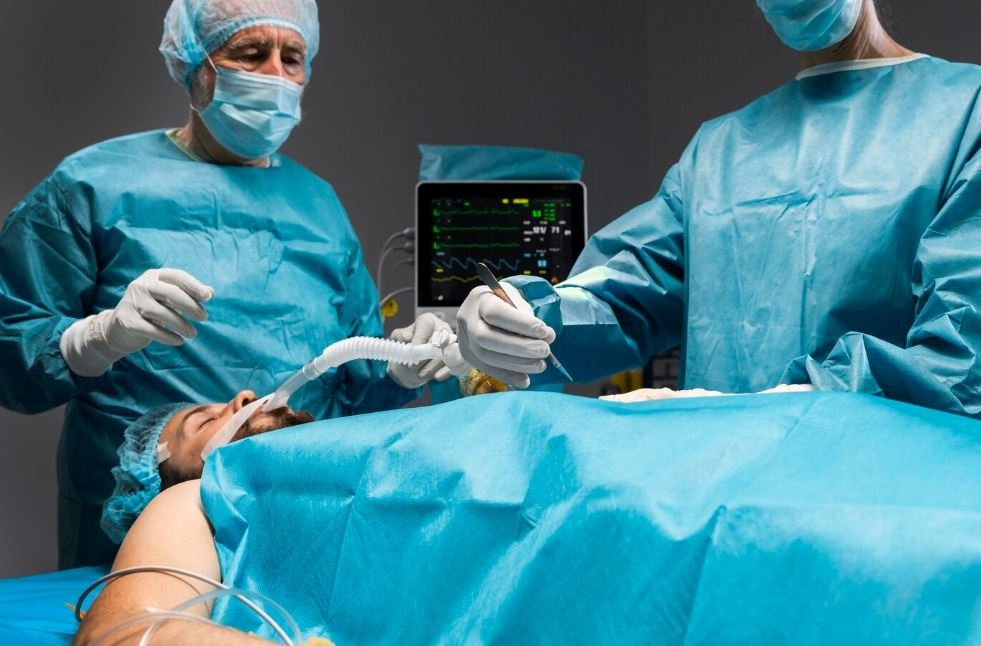
The possibility of long-lasting relief from the discomfort of heartburn, acid reflux, and swallowing issues is offered by hiatal hernia surgery. The underlying structural problem of a hiatal hernia, a condition in which a portion of the stomach pushes through the diaphragm into the chest, is addressed by this procedure. Hiatal hernia surgery has the potential to improve overall quality of life and lessen incapacitating symptoms through a variety of minimally invasive procedures or, in certain situations, open surgery.
Dr. John Smith – Expert in Hiatal Hernia Surgery
| Name | Dr. John Smith, M.D. |
|---|---|
| Specialization | General and Gastrointestinal Surgery |
| Education | M.D., Harvard Medical School |
| Experience | 20+ years in laparoscopic and abdominal surgeries |
| Affiliation | Cleveland Clinic, Department of Gastroenterology |
Why Is Surgery Required for Hiatal Hernias?
Although hiatal hernia surgery is not something to be taken lightly, it is frequently the next course of action for people whose symptoms are persistent and do not improve with medication or lifestyle changes. Repositioning the stomach in the abdomen to relieve pressure on the lower esophagus and restore its function is the main objective of the procedure. For people with severe gastroesophageal reflux disease (GERD), who have endured chronic discomfort and complications as a result of acid reflux, this is especially helpful.
Hiatal hernia surgery becomes an option when conservative measures like antacids, proton pump inhibitors, or lifestyle changes (like losing weight or avoiding trigger foods) are ineffective in treating heartburn, acid regurgitation, or difficulty swallowing. Furthermore, people with large hernias that cause the stomach to twist or obstruct may need surgery in order to prevent more serious complications like strangulation or bowel obstruction.
What Takes Place During Hiatal Hernia Surgery?
A hiatal hernia can be treated surgically in one of two ways: minimally invasive laparoscopic surgery or conventional open surgery. The size of the hernia, the patient’s general health, and the surgeon’s experience all play a role in the decision.
Laparoscopic Nissen Fundoplication, less invasive surgery:
- The abdomen is made with tiny incisions.
- The hernia is removed and the diaphragm is repaired using specialized tools and a laparoscope, which is a tiny camera.
- To prevent acid reflux, the upper portion of the stomach is wrapped around the lower esophagus to form a new, strengthened valve.
Open Procedure:
- For direct access to the hernia, a larger incision is made.
- This method is more intrusive, but it might be required in more complicated or large-scale cases.
The objective is always the same, regardless of the type of surgery: to minimize the diaphragm’s opening, restore the stomach and any impacted organs to their normal positions, and stop stomach acid from refluxing into the esophagus. This surgical procedure can end years of digestive discomfort for many patients, changing their lives.
Post-Surgery and Recovery Considerations
Depending on the technique and the patient’s health, recovery from hiatal hernia surgery can vary. Laparoscopic surgery patients usually recover more quickly, and their hospital stays last one to two nights on average. However, patients who need open surgery might have to stay longer.
Patients are recommended to adhere to a restricted diet in the weeks after surgery, beginning with liquids and moving on to soft foods as the body recovers. Allowing the stomach to rest and heal from the procedure is the aim. In order to prevent straining the surgical site, patients will also be required to refrain from heavy lifting and other demanding activities for a number of weeks.
Although complete dietary restrictions are typically removed after roughly six weeks, most people are able to resume their regular activities in a matter of weeks. Even after recovery, it’s critical to avoid foods that cause heartburn, such as spicy meals, coffee, and chocolate, in order to avoid symptoms from returning.
Alternative Therapies: Is Surgery the Best Option?
Endoscopic procedures such as Endoscopic Fundoplication (TIF) provide a less invasive option to surgery for certain patients. Surgeons can tighten the lower esophageal sphincter to stop acid reflux by using an endoscope, which is a flexible tube equipped with a camera. Even though this technique works very well for many people, it might not be appropriate in every situation, especially if the esophagus is severely damaged or the hernia is large.
Surgery is frequently the best option for long-term relief if it is advised, particularly for those with severe GERD or other hernia-related complications. Surgery can frequently remove the need for continuous medication, providing a longer-term, more affordable solution.
Complications and Risks: Things to Consider
Surgery for a hiatal hernia has risks, just like any other surgery. Possible issues include:
- infection where the wounds were made.
- blood clots or bleeding.
- bloating or trouble swallowing after surgery.
- harm to the surrounding organs or injury to the nerves.
- Rarely, spinal fluid can leak.
Although there are risks, they can usually be controlled with appropriate post-operative care, and minimally invasive procedures reduce the likelihood of complications. Surgery frequently has far more advantages than disadvantages, particularly for people who have had chronic symptoms for years.
In the end, a higher standard of living
For many people with heartburn, acid reflux, and other crippling digestive disorders, hiatal hernia surgery can significantly improve their quality of life. The procedure provides long-lasting relief and the chance to enjoy life without having to worry about digestive discomfort all the time by addressing the underlying cause of these symptoms.
Even though minimally invasive surgery is now the gold standard, improvements in surgical methods continue to speed up and simplify recovery. Surgery might be the answer that people need to regain their confidence, comfort, and health after trying every treatment without success.
